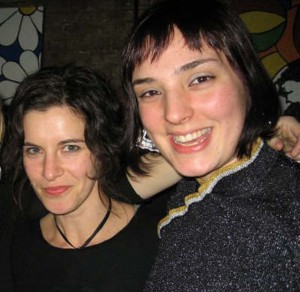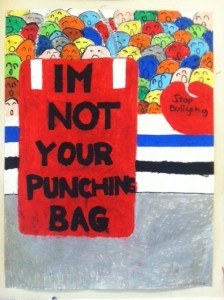Last week we introduced Catherine Karp and Cheryl Vernick. This week, in the sixth installment of Art21 Educators introductions, we’d like to introduce you to Dillon Paul and Angela Larsen!
Dillon lives in Brooklyn, NY and has been teaching Media Arts at the Flushing International High School in Queens for the past five years. Angela lives in Seattle, WA and has been teaching Studio Art at Dimmitt Middle School for the past three years. After graduating from NYU’s graduate program in Art Education, both Angela and Dillon share an interest in teaching with contemporary art to inspire their students to become socially engaged activists in their communities.
One of the things Dillon loves the most about teaching high school is the opportunity to provide students with tools of media and technology to share their ideas and experiences with the world. Flushing International High School is one of nine in a network of International Schools in the NYC public school system that exclusively serves recent immigrants to the United States. The school population represents almost 40 different countries and 20 different languages. Every student arrives with a different story, but one of the most common reasons for their relocation is the opportunity for a better education. Dillon feels that her students know better than anyone else what it means to pursue the American Dream.
[vimeo:https://vimeo.com/43987172]
In addition to being a teacher, Dillon is also a performance and video artist. Click here to visit her website to view examples of her artwork and teaching materials.
In her application to the program, Dillon described an interdisciplinary stop-motion animation project she recently developed using the work of William Kentridge as inspiration for her students to be able to share their stories:
“In Humanities class, students interviewed friends and family members, and then wrote creative non-fiction stories set in the past, present, and future. In my Media Arts class, students animated selected stories using clay characters, painted sets, and a variety of props, toys, and other materials. The stories were edited in Final Cut Pro with soundtracks to match the action and emotion in the story. Some of the big questions involved included: What benefit is there in sharing our stories? How can we visualize our experience to help tell our stories? What do we learn about ourselves by telling other people’s stories? How does the audience and context for presenting art work create, or change, its meaning?”
Click the following links to view examples of these projects here: Role Call (2011), Immigration Animations, War Animations (2008).
At the conclusion of the project students watched “Anything is Possible” and wrote an essay comparing William Kentridge’s process, materials and content with their own. This upcoming school year, Dillon plans to take advantage of the 2012 presidential election to revisit and revise a unit about the US presidential campaign she taught back in 2008, which was featured on the Art21 Blog.
[vimeo:https://vimeo.com/43987176]
Original application video shot and edited by Julia Welbourne.
Angela also works in a school that is diverse in terms of race, culture, and language ability. Dimmitt is a Title 1 middle school, and like many other public schools, focuses mostly on literacy, math and science. Angela’s goal is to provide her students with more opportunities to use their imaginations and think critically as well as creatively. Recently she has been using artist Kehinde Wiley to challenge her students to think about art in new ways. Wiley is known for his large-scale portrait paintings of contemporary urban African, African-American, Afro-Brazilian, Indian and Ethiopian-Jewish men in heroic poses. Wiley employs the style of Old Master paintings in order to comment on the image and status of his contemporary figures. Through Wiley’s work, Angela’s students have discussed the role of clothing, attitude and power in portrait paintings. They have also created their own works of art combining traditional artistic styles with unique contemporary perspectives.
In another project, Angela used protest posters to inspire her students to think about art-making as a social process. Students were asked to define the terms “social” and “social cause” and to reflect on their artistic process through writing. Angela described this project as a way to for students to develop their individual sense of identity, opinion and to establish a voice.
We’re excited to welcome Dillon and Angela into the program this year and we look forward to their contributions!
*This post was written with Dana Helwick, Art21 Educators Intern.








Pingback: Year Four Art21 Educators | Marni Kotak Rabinowitz and Hugo Rojas | Art21 Blog